How much metal would a Minnesota Green New Deal require?
There is an interesting paradox among liberal environmentalists.
On the one hand, they want a Minnesota Green New Deal where all the electricity in the state is provided by a combination of wind turbines, solar panels, and battery storage. On the other hand, they oppose mining for copper, nickel, cobalt, and other metals needed to build these energy sources, even though Minnesota has some of the largest undeveloped reserves of these metals in the world.
Today, we’ll conduct a rough estimate of how much metal would be needed to be completely reliant on wind, solar, and battery storage for electricity generation.
Assumptions
It’s important to remember that estimates like these are always based on assumptions, and it is important to lay out what the assumptions are, and where they come from. Our analysis of how many megawatts (MW) of wind turbines, solar panels, and battery storage come from this analysis prepared for Xcel Energy on behalf of Energy+Environment Economics (EEE).
Under the “No Fossil” scenario, EEE estimated Xcel would need 15,000 MW of wind, 21,000 MW of solar, and 24,000 MW of batteries that can last for five hours. We then doubled these estimates because Xcel Energy accounts for about half of Minnesota’s electricity generation, according to data from the U.S. Energy Information Administration. This gives us a rough estimate of the amount of wind, solar, and storage needed to provide for nearly all of Minnesota’s electricity generation under a Minnesota Green New Deal.

For metal content for each of these technologies, we use this analysis produced by the World Bank, which shows how much metal is needed for each MW of wind, solar, and battery storage. Using these two sources, we can approximate how much metal would be needed to achieve the Walz administration’s goal of generating all of Minnesota’s electricity from carbon-free energy sources while excluding large hydro and refusing to legalize new nuclear power plants in the state.
Lastly, it is important to remember that these figures are likely conservative because the World Bank report does not account for the large quantities of metal used in transmission lines, substations, and distribution systems. For example, a recent analysis from Wood Mackenzie concluded that most of the copper used for wind turbines is for collector cables, transformers, substations, distribution cables, and tower cables.

The World Bank study only estimates the materials needed for building the wind turbines, solar panels, and battery packs. The estimates do not account for the massive amount of metal that would be needed to actually connect these energy sources to the grid.
How Much Metal Would This Take?
Dozens of different metals are used in each of these sources of electricity. Some of the most common metals are aluminum, cobalt, copper, iron, nickel, steel, and zinc. If you add up all the metals that would be needed to build the grid solely on wind, solar and storage, it would require 5.8 million tons of processed metals. For context, a fully-grown blue whale weighs about 200 tons.
This means we’d need the equivalent of 29,177 blue whales worth of metals to build the wind turbines, solar panels, and batteries for this plan.
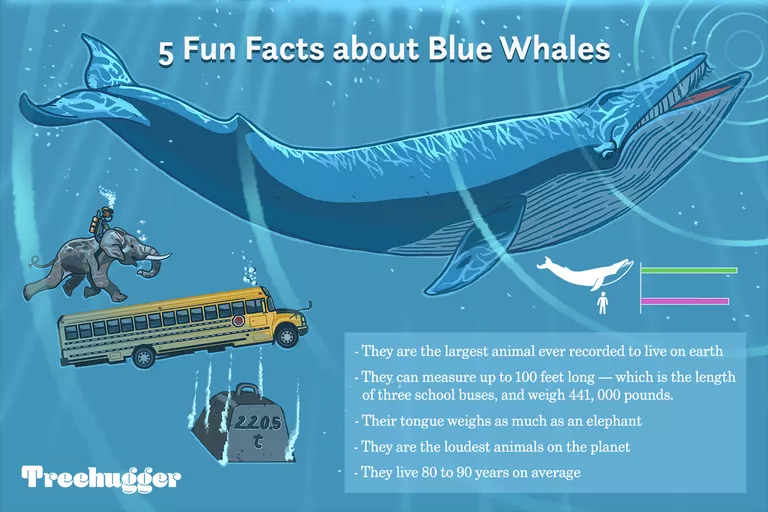
When it comes to some of the more-familiar metals, it would take more than 182,533 metric tons of copper, 116,000 metric tons of nickel, 60,000 metric tons of cobalt, 1.02 million metric tons of iron, 3.45 million metric tons of steel, and 14,000 metric tons of lead to build the required solar panels, wind turbines, and battery packs.
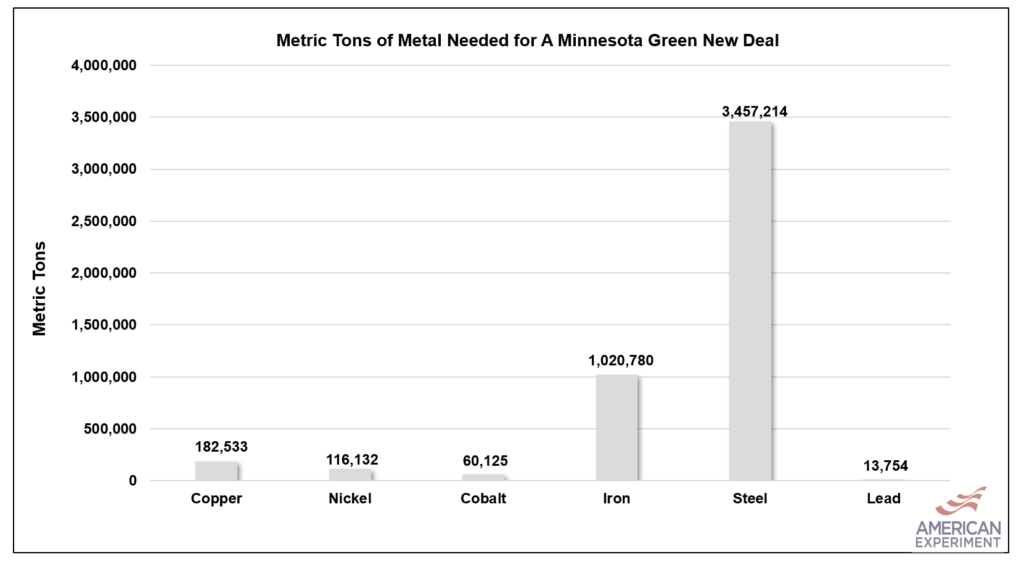
These may or may not seem like large numbers to you, so it helps to put them into perspective.
Copper
The amount of copper needed to build the wind turbines, solar panels, and battery packs is relatively small compared to global copper production. According to the United States Geological Survey, global copper production is around 20 million metric tons, meaning building these wind turbines and solar panels would account for about 1 percent of global copper consumption.
While a Minnesota Green New Deal would consume only a small portion of global copper production, it would consume about 14 percent of US copper production.
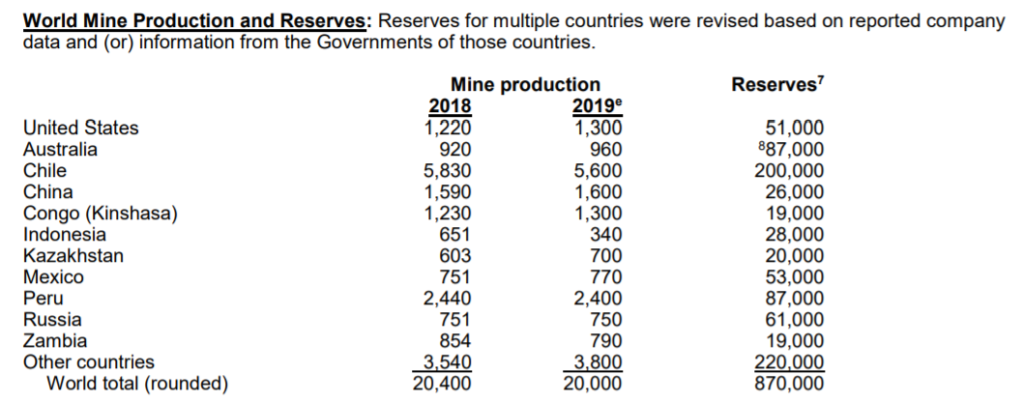
The amount of copper needed would jump to 283,000 metric tons if we use the Wood Mackenzie estimate of approximately 7 tons per MW of installed wind capacity, bringing Minnesota’s copper consumption to 1.56 percent of the global copper production in 2019, and 22 percent of U.S. copper production.
This means Minnesota, a state that comprises 0.07 percent of the global population would consume up to 1.56 percent of global copper production from 2019 to build this grid.
Nickel
Global nickel production in 2019 was 2.7 million metric tons. Only 14,000 were produced in the United States, as you can see in the table below.
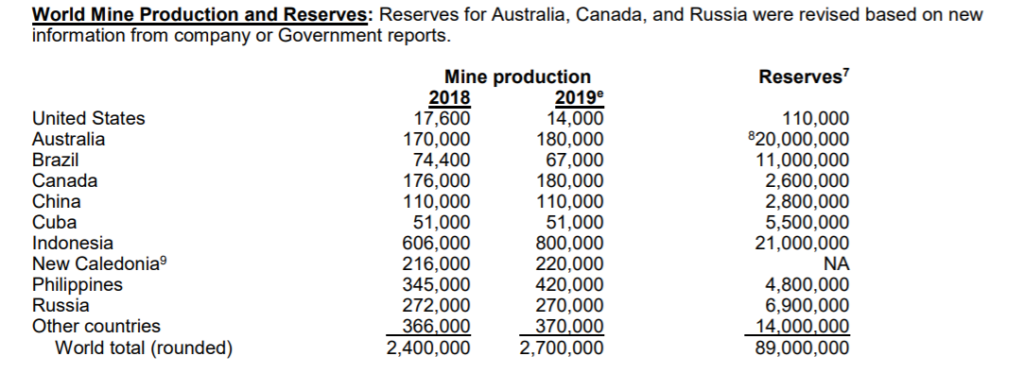
This means that a Minnesota Green New Deal would require 4.30 percent of the global total of nickel mined in 2019. If this nickel were to be mined domestically, it would take more than 9 years of Minnesota consuming the entire U.S. output to build the wind turbines and battery packs laid out in the Xcel presentation.
This could change, however, if Minnesota would mine the vast nickel resources in the Duluth Complex, which are the largest undeveloped deposits in the world.
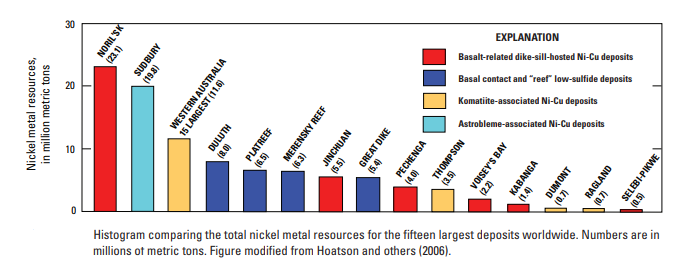
The amount of nickel needed would increase even more if Minnesota were to increase the use of electric cars because nickel is a key ingredient in electric car batteries. Increasing the number of electric vehicles by nearly 1 million cars, as the Walz administration wants to do, would increase the demand for nickel significantly.
Cobalt
Cobalt is another ingredient in lithium ion batteries, and a Minnesota Green New Deal would require 60,000 metric tons of it. This may not sound like a lot, but world cobalt production was only 140,000 metric tons in 2019, meaning Minnesota would require 43 percent of global cobalt output to build the batteries needed to store electricity produced by wind turbines and solar panels.

As you can see in the table above, the vast majority of the world’s cobalt output comes from the Congo. While about 66 percent of the cobalt mined in the Congo is done with machinery in deep pits, but a growing amount of cobalt (about 30 percent) is dug by hand by 150,000 miners, 40,000 of them children, according to the Financial Times.
Minnesota has the largest cobalt reserves in the United States, and the PolyMet Mine and Twin Metals mine would be developing two of the three-largest domestic cobalt deposits, according to data from the United States Geological Survey.
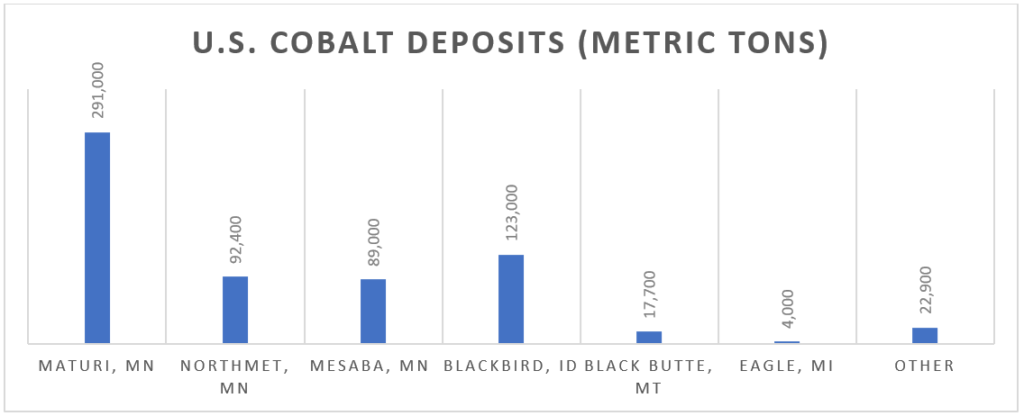
Minnesota can’t replace all of the cobalt mined by children in the Congo, but it could help provide a supply of ethically-sourced cobalt for our lithium ion battery needs while helping to boost Northern Minnesota’s economy at the same time.
Iron and Steel
Minnesota is the largest producer of iron ore in the United States, but the country is still a net importer when it comes to steel. The Minnesota Green New Deal would require more than 1 million metric tons of iron, and 3.4 million tons of steel, meaning it would require only 0.07 percent of global iron production (the table below is in million metric tons), but it would account for about five percent of U.S. iron supplies.

The Minnesota Green New Deal would require about 0.18 percent of global steel production, and about four percent of U.S. production.
Conclusion
Wind turbines and solar panels require massive amounts of metals, largely because these energy sources are not very reliable, which means they also require battery storage, and also need to be “overbuilt” to ensure there is enough electricity when it is cloudy or on calm days with slow wind speeds. The same people who are the loudest supporters of wind and solar put their heads in the sand when it comes to mining the materials needed to build them.
These materials can either be mined in the United States, where protections for workers and the environment are strong, or they can be mined in foreign countries that have few if any, protections for the environment, or the miners. Ironically, it is the same people who drink fair trade coffee who are the most likely to oppose mining for fair trade copper, and fair trade cobalt, right here in Minnesota.